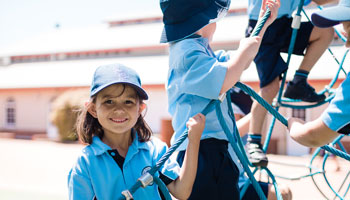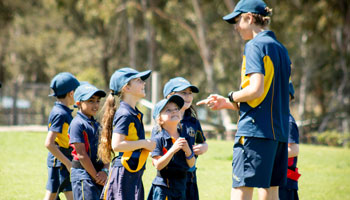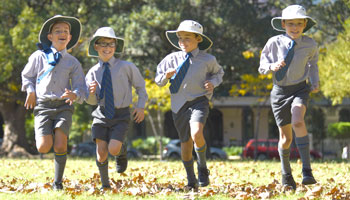Schools need to be mindful of having good policies and proactive measures to support sun safety behaviours.
Concerns have been raised that schools may become the subject of litigation should students suffer illness or injury arising from overexposure to the sun while at school or undertaking co-curricular activities.
Claims against employers under Worker’s Compensation legislation for solar damage have been successful where it can be shown that the nature of the employment was a substantial contributing factor and the solar damage was contracted in the course of the employment.
Skin cancer is highly preventable and school communities play an important part in proactive measures to support the sun safety behaviours of our children and young people.

Policies such as ‘no hat, play in the shade’ are simple protective measures for students.
In the case of a claim against a school, it would be necessary to establish the solar damage occurred at school or during school activities and that it would not have occurred had the school taken reasonable steps to protect students as required in discharging their duty of care to students. It is beyond argument that solar damage to students who spend significant time outside at peak UV times is a reasonably foreseeable injury, but proving that the injury occurred at school may be very difficult, particularly if the injury was not apparent soon after it occurred.
The nature of the solar damage could include sunburn, heatstroke, actinic keratoses (pre-cancerous), skin cancers and, at the worst end of the scale, melanoma. The damage can be to skin and eyes.
Schools that provide outdoor sporting activities, which involve long periods in the sun, should be particularly careful in considering what steps they should take to minimise the risk to students.
There does not appear to have been any reported cases where students have been successful in court proceedings taken against a school arising out of sun-related injuries, but it would appear some legal proceedings have been commenced where students have suffered severe sunburn.

Sun-safe practices should be delivered to students from K-12.
It would appear that while preschools and primary schools are usually careful about protecting their students from the sun and often have policies such as ‘no hat, play in the shade’, secondary schools are less inclined to take such steps, probably in the reasonable belief that students in secondary schools are more mature, more aware of the risks of sunburn and more inclined to take measures to avoid these risks by avoiding the sun and using sunscreen and protective clothing. However, it would be dangerous to assume that this would always be the case, and there will always be students who are unaware of or choose to ignore the risks.
Reasonable steps to protect students from sun injuries
It would be prudent for schools to be able to establish that they took reasonable steps to protect students from damage caused by the sun’s UV.
Steps could include:
- reviewing current practices to ascertain where any significant risks arise
- developing sun protection policies that are designed to reduce risks from exposure to the sun’s UV and are suitable for students in K-6 and Years 7-12.
- provide instruction in sun-safe practices for all students K-12
- ensure that policies are being followed and that staff are aware of their obligations
- record all measures that have been taken and maintain these records for not less than 50 years, so that evidence of the 'reasonable steps' remains available.

Schools may consider including in their risk warnings for recreational activities.
Outdoor sporting activities
Those schools that provide outdoor sporting activities such as rowing, sailing and cricket, which involve long periods in the sun, often without clothing that protects the skin or glasses to protect the eye area, should be particularly careful in considering what steps they should take to minimise the risk to students.
The Cancer Council provides information on SunSmart policies for primary schools in addition to curriculum resources for teachers on lessons relating to sun safety for students. The Cancer Council also has a Sample SunSmart Policy for OSHC services and provides a SunSmart App to assist in determining appropriate measures to take depending on the UV forecast.
A whole-school approach to sun safety enhances the health and safety of students through parent education via newsletters, teacher’s role modelling sun-safe behaviours for students, shade considerations as well as sun protection policies.
Rowing New South Wales and some other sporting organisations have sun protection policies that schools should be familiar and incorporate into their own practices.
Schools may also wish to consider including in their risk warnings for recreational activities under Section 5M of the Civil Liability Act referring to the risk of sun damage when students are taking part in activities that involve spending long periods in the sun. A risk warning will not be effective if the activity was compulsory.

A whole-school approach to sun safety enhances the health and safety of students.
Everybody plays an important role in student sun safety
The good news is that skin cancer is highly preventable and school communities play an important part in proactive measures to support the sun safety behaviours of our children and young people.
The NSW Personal Development, Health and Physical Education (PDHPE) K-10 Syllabus addresses sun safety from Early Stage 1 to Stage 5 through explicit content and skills to enhance the health and safety of students and the community. This includes preventative practices and strategies to decrease lifestyle diseases such as sun protection (Slip Slop Slap Seek Slide) and skills to advocate for their own and others' health including decision making, finding solutions to problems, help seeking and leadership.
A whole-school approach to sun safety enhances the health and safety of students through parent education via newsletters, teacher’s role modelling sun safe behaviours for students, shade considerations as well as sun protection policies for PDHPE and other outdoor activities including sport and assemblies.

School communities play an important part in proactive measures to support the sun safety behaviours.
There are many resources available to schools to support sun safety education:
More information on preventative whole-school and PDHPE approaches to Sun Safety
Please contact:
Katrina Mostyn, AISNSW PDHPE and Wellbeing Consultant
Nicky Sloss, AISNSW Senior Wellbeing Consultant
Photo credit: With thanks to Belmont Christian College, Coogee Boys Preparatory School, Rouse Hill Anglican College and The Nature School.
New to AISNSW and want to receive AISNSW Education News updates? Click here to register, and select ‘AISNSW Education News’ on the Areas of Interest/Subscriptions page.